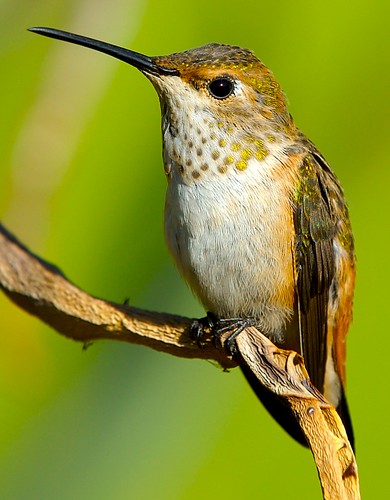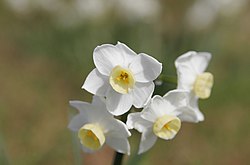One of the tools in the photographer's toolbox is Depth of Field (DoF), which is the parameter that will define the part of the picture in focus, and the portion out of focus (blurred).
In the above photograph, the DoF is very shallow: almost only the bird is in focus, and the background is so blurred it is hard to know if it is grass, bushes, trees, or a piece of green cardboard!
DoF: measure it? Calculate it!
To be more precise, the Depth of Field is the zone within the focus near limit and far limit: everything before the near limit and after the far limit is considered out of focus. Yes, the DoF is actually a distance! Ok, maybe you were already aware of it. But did you know you can calculate it? Physicists and Mathematicians are amazing. They have built a model to calculate, or rather make an approximation of the DoF. Here it is:Where
- D is the distance between the camera and the subject (m),
- H is the hyperfocal distance (m).
Where
- f is the focal length (m),
- N is the f-Number (no unit),
- c is the circle of confusion for the film/sensor of the camera (m).
In any given situation, with these formulae, you can calculate the DoF, pretty interesting, uh? Sorry for the Maths, but it is solely for the sake of explanation. I bet you don't want to calculate DoF with the formula by yourself; luckily, there are several websites which offer to do the calculation for you, here are a few examples:
- fcalc.net can calculate DoF among other interesting things,
- dofmaster provides a nice DoF calculator and other useful stuff.
Manage DoF
Depth of Field is essential in a phtograph, you definitely want to manage it. How? I will help you out, by analyzing the formula from the previous paragraph.Many parameters appear in the formulae, let's have a look at them:
- D, the distance between the camera and the point you set focus on. You can change this parameter by moving or by making the subject move, but this will obviously have an effect on composition,
- f, the focal length, can be changed either by setting it on your lens or by switching lenses (if you have more than one). This will also obviously have an effect on composition,
- N, the f-Number, is the most easy parameter to change, you just have to set it on your camera (if available). It determines how wide the diaphragm opens. This has an effect on how much light is transmitted to the film/sensor (the greater the f-Number the less light is transmitted),
- c, is a constant determined by the size of the film/sensor. Thus it is not possible to change it (except if you use a different camera).
Out of 4 parameters, 3 can be easily changed: let's focus on these elements and take a real situation as a case of study.
You own a Canon 1DX camera (yes, you are rich!!) and a EF 24-70mm f/2.8L USM lens. The sensor has a circle of confusion of approximatively 0.03mm (0.00003m).
You want to take a picture of a bird on a tree with bushes behind, which is 4m away. At first, you set the f-Number to f/4 and the widest angle available by setting the focal length to 24mm (0.024m).
In the start situation, using dofmaster's calculator, you know you have a DoF of about 21.1m. That means the bird, the tree and probably the bushes will appear sharp on the photograph no problem.
Now, go 2 steps back, let's say one meter. You are now 5m from the bird, the DoF is infinite and all the landscape is sharp!
Go 4 steps forward, you are 3m from the bird, the DoF is now 6m and the bushes are a little blurred.
Go 2 more steps forward and (2m from the bird), if the bird did not flee, the DoF is now 2m and even the tree is not sharp everywhere.
As you can see, the distance to the subject can change the DoF a lot. The closer to the subject, the more shallow the DoF.
Let's go back to the start situation. The DoF is 21.1m.
Instead of stepping forward, we want to zoom in using the focal length. We increase the focal length to 48mm, and the DoF falls down to 1.72m! Goodbye background, bird is the center of attention.
When you think about it, stepping forward or zooming in have the same influence: the subject seems closer. Same conclusion as before, the closer to the subject, the more shallow the DoF.
Back to the start situation. You want to play with the f-Number now.
Let's set it to 5.6 (one stop): the DoF is now infinite.
Set it to 2.8 (one stop the other way): DoF = 7.1m.
The lower the f-Number, the more shallow the DoF.
As you can see, these three parameters have a great influence on Depth of Field. But nothing comes without a counterpart.
Consequences
By reading the following paragraph, one might want to conclude it is easy to adjust the DoF: simply change the f-Number! Unfortunately, nothing is simple and photography is a matter of balance.You can increase the f-Number to increase the DoF, this is right. The counterpart is less light will be transmitted to the sensor. To keep a good exposure, you will have to either increase the exposure time or the ISO: the first will result in possible motion blur (which is neither good or bad but changes the picture), the second might add noise. Not to mention if you are in a low light situation, you might want to use as much light as possible. See? Not that simple.
Moving forward or backward from your subject also changes the DoF, but it changes the composition in a strong way, so does focal length adjustment.
Worse, lenses do not provide the same image quality for every focal length and every f-Number. Got a headache yet? Calm down. In a given situation, what you want to think thru is: what result do you want to get?
Then what do you need to do? Experience! Try things out, get to know your gear better, explore. Theory alone is meaningless.
version française





No comments:
Post a Comment